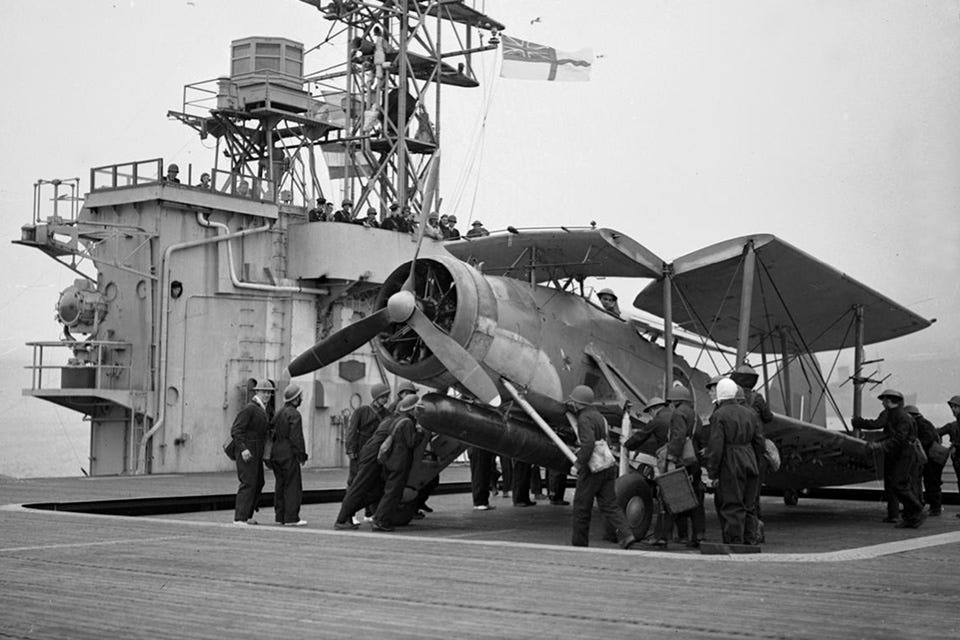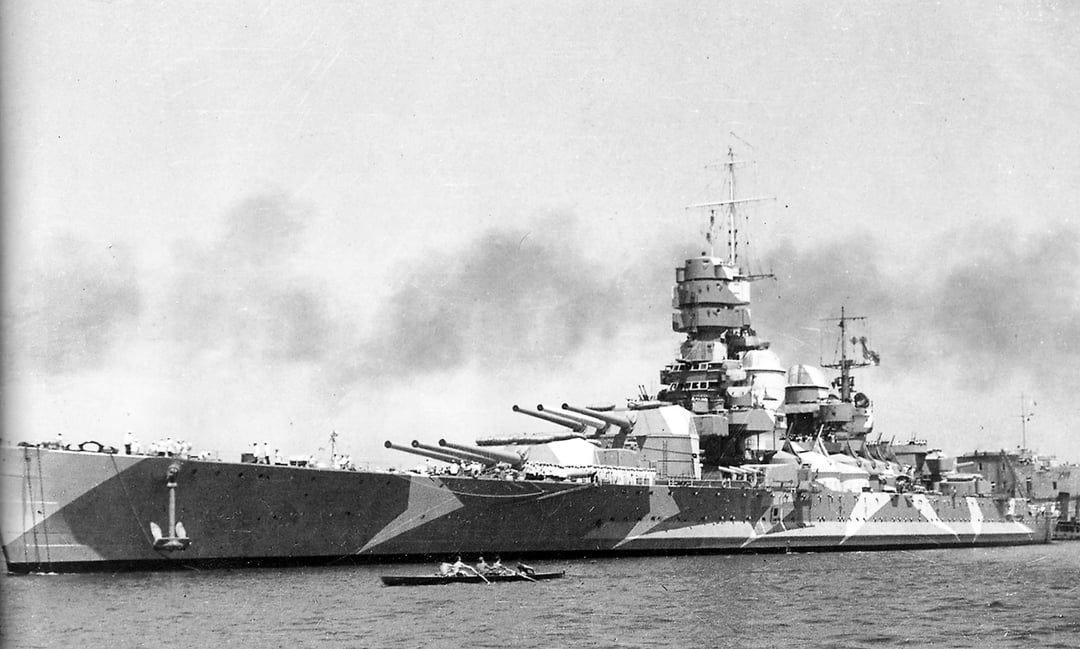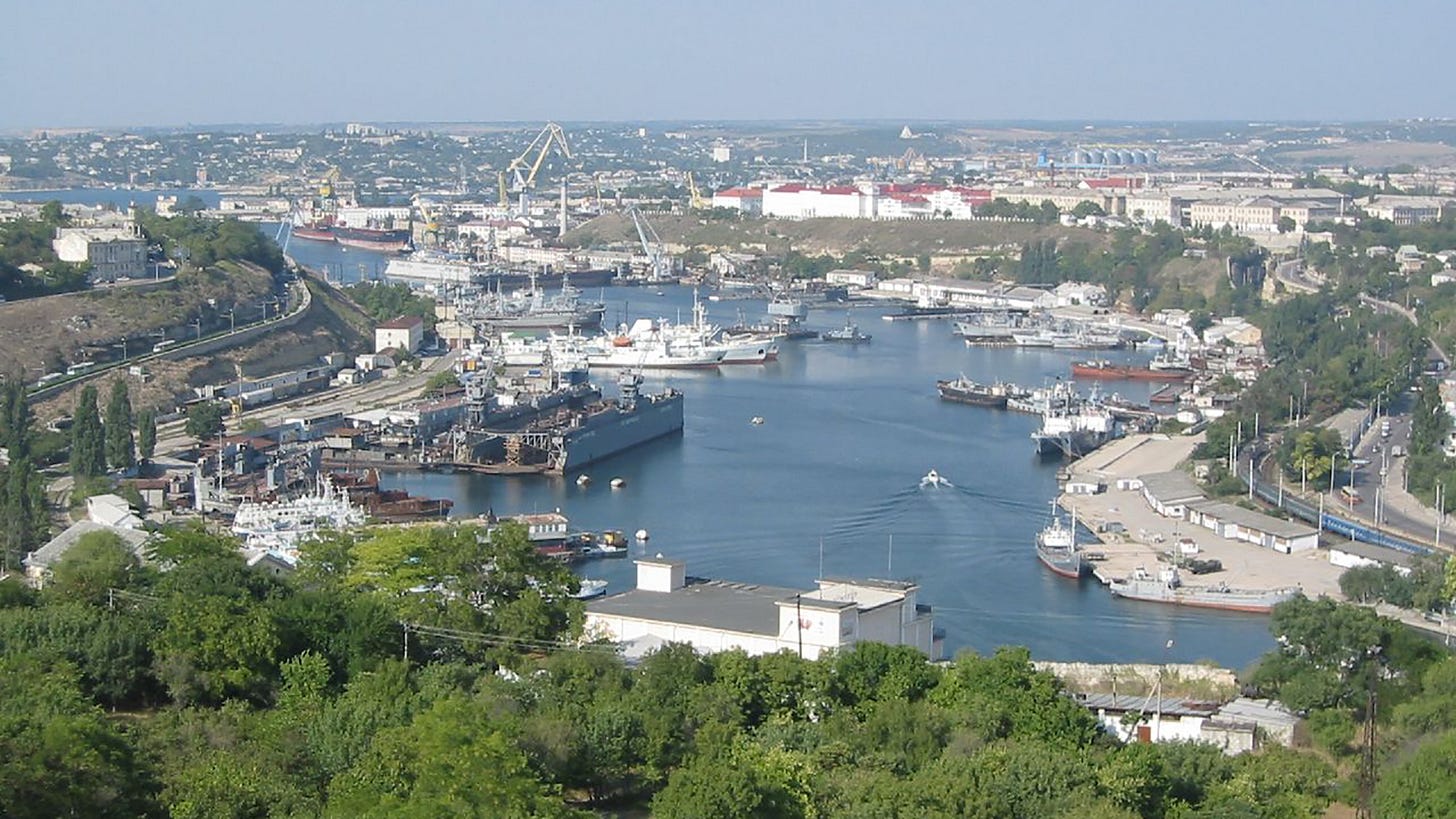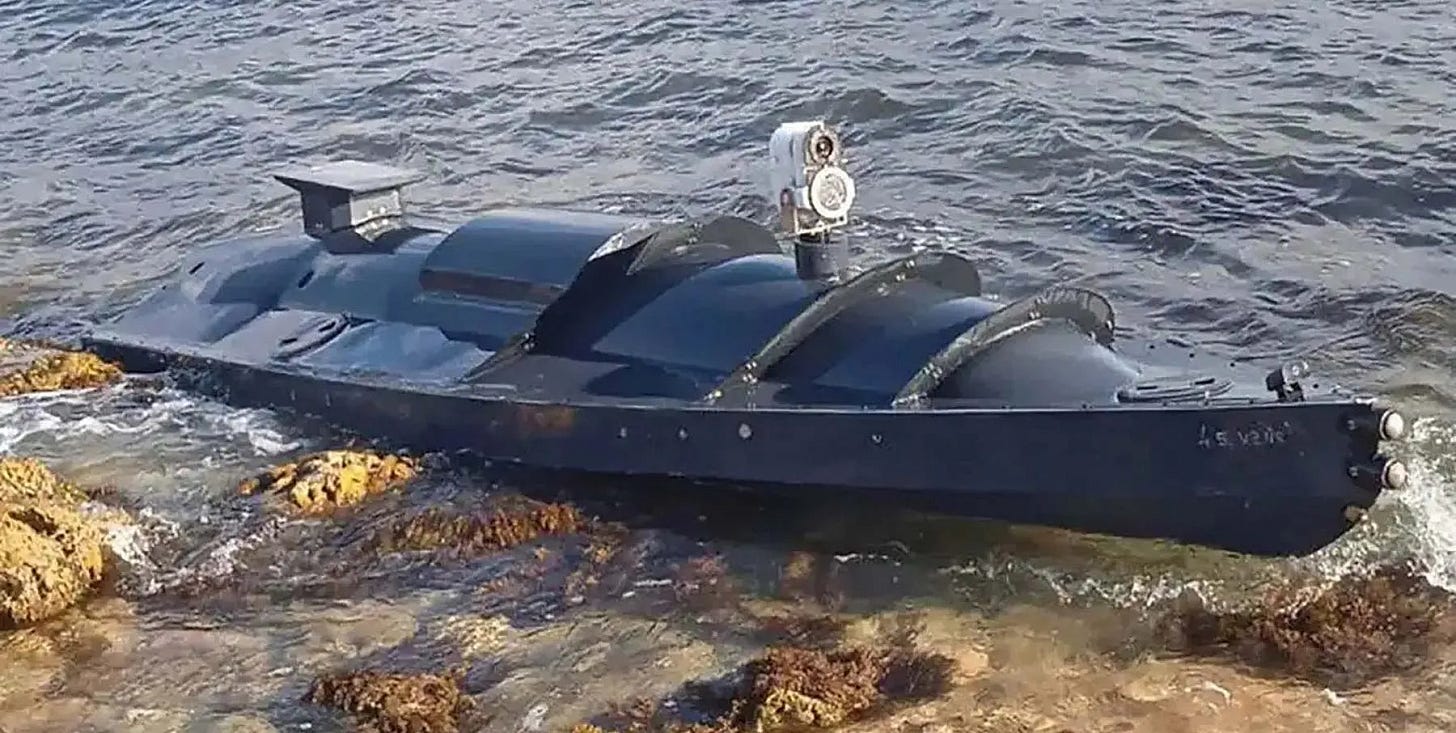Lessons From The Taranto Raid: Decisive Naval Engagements & Ukrainian Maritime Strategy
Where bold strategy and cost-effective weapons payoff.
As the quiet and obsolete Royal Navy (RN) torpedo bombers roared above the waves towards their moonlit prize, the Italian fleet at Taranto was about to realize its mistake in undermining the Fleet Air Arm’s premier maritime strike capability of the 1940s; and its ships would pay the price.
The Swordfish torpedo bomber had its origins in early 1930s. when the Middlesex-based aviation company “Fairey” began developing a new biplane bomber for service in the Royal Navy. With canvas covered folding wings and a modest maximum speed of 138 miles per hour, the Swordfish—nicknamed “Stringbag”—was an inexpensive, carrier-capable aircraft, which was ground-breaking at its debut.
By 1940, the Italian Regia Marina (RM) brought to bear its modern fleet and shore-based fighter aircraft against the now-outdated flimsy metal struts of the Swordfish. Belittled and on the back-foot, British naval planners sought a quick replacement for the platform, giving the obsolete bomber little time to find its place in history.

The Fascist Menace & Its Fleet
Early in the war, the British and Italian fleets were battling for naval superiority in the Mediterranean. Taranto, located at the heel of the Italian boot, housed most of the Italian battle fleet in 1940 and stood in the midst of the vital sea lanes that linked Britain to most of its colonies via Gibraltar and the Suez Canal.
The Italian government had poured substantial resources—most important time—into modernizing and constructing a modern fleet. With a naval force comprising of top-of-the-line battleships, marine aircraft, and submarines; the RM was poised to defend itself in the Mediterranean and topple the RN’s longstanding dominance of the region.
British commanders knew that to regain supremacy of the seas, the RN’s Mediterranean Fleet would have to muster its overstretched forces to successfully decapitate the best of Italy’s warships. The Swordfish was heading to Taranto.
Measuring Center of Gravity
By September of 1940, strategic defeats were mounting against the Allies. France had fallen, the Blitz was raging over London, and the Italian Army was nearing Cairo. The responsibility of countering the RM would rest almost entirely with the Alexandria-based Mediterranean Fleet, a force that was outmatched in nearly every category of warship—except one.
For weeks, British planners had been eyeing an assault on the Italian battle fleet at Taranto, considering it a potential blow to Italy’s center of gravity for the battle over the Mediterranean. On November 9, reconnaissance confirmed that the Italian fleet’s strength—consisting of the formidable Littorio, Vittorio Veneto, Giulio Cesare, Caio Duilio, Andrea Doria, and Conte di Cavour—was concentrated in the port, with the first two ships being newly commissioned in 1940.
Along with these behemoths were several cruisers and destroyers, all strategically moored at the heart of Italy’s naval power. The intelligence was clear: the opportunity to cripple the RM’s ability to project force across the Mediterranean was too valuable to ignore

Operation Judgment
On the night of 20 November, 1941, The RN Fleet Air Arm launched just 21 Swordfish torpedo bombers from the carrier HMS Illustrious to cripple the Regia Marina at its main anchorage in Taranto.
The attack, executed in two waves, sank one battleship, severely damaged two others, and inflicted significant losses on Italy’s naval capability—all at the cost of only two aircraft and minimal casualties. This operation exemplified several key principles: strategic surprise, the effective use of available technology, and the exploitation of enemy vulnerabilities.
The RN, recognizing Italy’s early naval successes in the Mediterranean, opted for a high-risk, high-reward strategy rather than engaging in a prolonged attritional struggle—that would take away assets from other theaters. The RN leveraged aerial torpedoes, night-time operations, and superior intelligence to inflict disproportionate damage relative to their force size. The psychological impact was just as crucial, as the attack demonstrated that even well-defended ports were vulnerable to aerial strikes.

“Stringbags” in the 21st Century
In 2025, Ukraine faces a similarly daunting challenge against Russia, whose Black Sea Fleet remains a formidable opponent. Since the 2022 invasion, Russia has used its naval superiority to blockade Ukrainian ports, launch missile strikes, and threaten Ukraine’s strategic sealines of communication. Yet, Ukraine has demonstrated remarkable adaptability, particularly with its use of unmanned surface and aerial vehicles—much alike the cheap and efficient “Stringbag” Swordfishes—to strike Russian naval assets.
In a modern parallel to Taranto, Ukraine’s innovative deployment of maritime drones has inflicted unexpected damage on the Russian Black Sea Fleet. The attacks on Sevastopol in late 2022 and the damaging of the Russian landing ship Olenegorsky Gornyak in August 2023 illustrate how a technologically inferior force can utilize asymmetric warfare to neutralize a numerically superior adversary in detail.
Just as the British exploited Italian vulnerabilities at Taranto, Ukraine has capitalized on Russia’s reliance on centralized naval bases, the limited defensive capabilities of its ships against drone swarms, and the strategic bottleneck of the Bosphorous Straits—preventing reinforcements from other theaters.
Learning from Taranto: Keep a Fleet In Port
Several key lessons from Taranto are directly applicable to Ukraine’s ongoing naval strategy:
Defeating “Fleet in Being” – The destruction of key naval assets does more than just diminish operational capability—it reshapes enemy decision-making. The psychological impact of Ukraine’s attacks has already forced Russia to reposition assets, redeploy air defenses, and increase naval patrols, stretching its resources and introducing defensive inefficiencies for its Black Sea Fleet.
The Power of Surprise – The Taranto Raid succeeded because the Italian fleet was caught off-guard. Ukraine’s continued ability to keep Russia guessing about the timing and nature of its attacks is critical. Unpredictable strikes on naval bases, logistics hubs, and high-value ships can erode Russia’s confidence and force costly defensive adjustments.
Asymmetric Innovation – Just as Britain leveraged aircraft carriers and torpedo bombers to achieve strategic effects beyond their numerical strength, Ukraine must continue pioneering the use of unmanned maritime vehicles, precision missile strikes, and electronic warfare to offset Russian naval dominance—all of which are applicable to U.S. naval strategy as we modernize the fleet.
Targeting Logistical Chokepoints – Taranto demonstrated that even a few well-placed strikes on infrastructure and fleet units can cripple a larger navy’s operational effectiveness. Ukraine’s focus on striking Sevastopol, Novorossiysk, and logistical support vessels mirrors this strategy. By disrupting Russian supply lines and fleet readiness, Ukraine can degrade its adversary’s overall effectiveness.
Lessons Learned With Blood
The Taranto Raid underscored the reality that naval supremacy is not solely a function of fleet size but of strategy, surprise, and technological adaptation. Ukraine, much like Britain in 1940, faces a superior naval opponent but has found ways to level the playing field through unconventional warfare. By continuing to apply the principles demonstrated at Taranto—leveraging innovation, exploiting enemy vulnerabilities, and maintaining strategic unpredictability—Ukraine can further erode Russia’s ability to project power in the Black Sea and turn the tide of the conflict in its favor.



